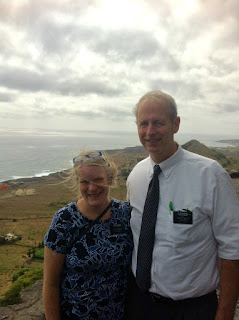Apartment Inspections
We have been asked by our mission president, Presidente Mathews, to inspect all of the missionary apartments on the island of Santiago at the end of each transfer. We think it's fun because we get to see the Missionaries, many of whom I have spoken to over the phone. It's a road trip around this beautiful island. The 27 apartments do not have street addresses, so it's like finding farms in the Missouri countryside, "turn right at the green building, go up the hill...."
So last week we traveled, visiting missionaries and take them supplies. We drove through valleys with banana plantations, and along the coastline. This is a volcanic island so the soil is rich, and where there is water, wonderful things grow.
We saw large bundles of sticks, perhaps for cooking fires, loaded onto trucks and being carried home by women. Here is a woman carrying a bundle on her head, kind of blurry because we were passing her on the road.
And these are some of our wonderful missionaries working on the northern part of the island. We arrived early morning on "P" day, which explains their casual attire. Elder Sobral is from Brazil, he is in his first transfer (just like us!) and Elder Alvez is a seasoned missionary from Cape Verde. Elder Alvez has a special place in my heart because a few weeks ago, when we were following a health concern together, he called one evening just to say everything was fine (that never happens.) Best nursing call I've gotten! He and Elder Sobral are native Portuguese speakers so I initially struggled to understand why he was calling, because he didnt seem to have a problem. He was so reassuring I was able to figure it out. Bless their generous, kind hearts!!!
Chickens

Here is the last photo, Elder Biven is walking in to finalize arrangements for purchasing our chickens, which will be delivered next Tuesday. Here is a thumbnail sketch of the organization of the member welfare project for families to raise chickens: The project leaders are the Stake and District Presidents, with Elder Biven serving in an advisory role. Through the recommendation of Bishops and Branch Presidents two families per unit were selected on criteria the leadership identified. They receive chickens to raise to supplement their family's food supply and income. One requirement was that these families had to complete the Church's twelve week self reliance course.
And as the families have prepared to receive the chickens, we have been procurring the chickens, organizing coop construction (more about that later, I am sure) figuring out feed requirements....obtaining chickens is monumental on Cape Verde. Fortunately, our predecessors, the Carnells, forged a path. And, while we are buying month old chickens, a big deal here, we cannot distribute the chickens until they are sixteen weeks of age and have had all their vaccinations. So we have arranged with a local person to take care of our 320 chickens (we are only doing those for our island at first, the other 300+ for Fogo will happen after we get through the first group......whew).
While the young chickens are growing locally, we will shuttle feed across town in our little missionary sedan (all that time Elder Biven spent at the gym before the mission will now be justified as he loads 40 kilo chicken feed bags into our trunk each week). We have also hired someone to check on the chickens frequently. This good man will ride his motorcycle across town multiple times each week to check that they are being fed, being watered, and not leaving the area..... meaning, watching them so they are not stolen.
Funny story about stolen chickens.... when we first arrived, we inspected chicken coops from the first member welfare chicken project (which is probably why we were assigned to inspect the missionary apartments-- we have experience). As we inspected those first coops around Praia, we met the man we wrote about on an earlier entry who was keeping the chickens on his roof to deter thieves. Which could work, except the thieves had gotten a few of his chickens anyway. When we asked him what the security problem was, why the dogs did not at least bark and warn him, he shrugged his shoulders and said, "the dogs knew the thieves"..... Life on a small island.
We are so grateful to be able to serve the people of Cape Verde. We are inspired by their faith and hope in the gospel of Jesus Christ. It is an honor to be among them. We are also grateful to the young missionaries who serve here. We see them out walking to appointments in the heat. They do not have air conditioning in their apartments, they have fans, and sometimes the fans break. Many do not have hot water and some have no running water at all for days. And they keep working, serving God by teaching the gospel to those who want to hear it, and spreading joy. This is amazing!





















































